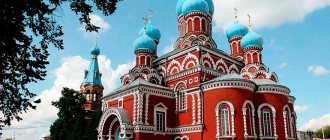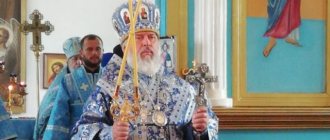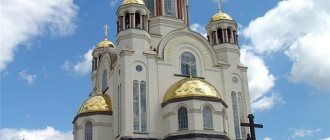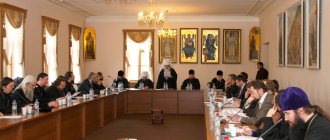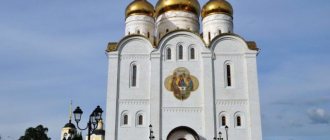| Tomsk Epiphany Cathedral |
Tomsk and Asinovskaya Diocese
of the Tomsk Metropolis of the Russian Orthodox Church
Occasionally the ancient Tomsk diocese in the western Black Sea region is called “Tomskaya”.
- Diocesan administration: Russia, 634000, Tomsk, Lenin Ave. 119
- Tel.; fax: 51-13-85
- Official site:
- Canonical territory: GO Tomsk, Kedrovy, Seversk; Asinovsky, Zyryansky, Kozhevnikovsky, Pervomaisky, Teguldetsky, Tomsk, Shegarsky districts of the Tomsk region.
- Cathedrals: Epiphany in Tomsk, Intercession in Asin
- On the map: Yandex.Map, Google map
Tomsk was founded in 1604 by decree of Tsar Boris Godunov and by order of the sovereign, the first wooden church was erected in the city in the name of the Life-Giving Trinity, around which church life began to be built on Tomsk land. In Siberia, after its annexation to Russia, the Tobolsk diocese was the first to appear in 1620 and the territory of the current Tomsk diocese is part of it.
Temples and chapels were built in Tomsk and the surrounding lands, and the number of Orthodox Christians increased both due to the settlers who were settling in Siberia and due to the local residents who accepted Orthodoxy. By the middle of the 17th century, the need arose to open an independent department in Tomsk. This issue was considered at the Great Moscow Council of 1666-1667, where it was determined:
“For the sake of the church dispensation: and according to the jealous desire of the pious Autocrat: Tsar Alexy Mikhailovich: we, Orthodox patriarchs - Paisius, by the grace of God, pope and patriarch of Antiochai and the whole East; Joseph, Moscow and All Rus', His Eminences, Metropolitans, Archbishops and Bishops and the entire consecrated Council, blessed and established in the kingdom of Siberia, in Tobolsk with the surrounding cities, instead of an archbishopric and metropolis to be, in the city of Tomsk - to the bishop"
.
The ancient wooden church in the name of the Holy Trinity became the cathedral of Tomsk, and after it was dismantled due to disrepair in 1819, the Annunciation Cathedral [1].
However, no bishop was appointed to Tomsk, and Tomsk parishes continued to be under the omophorion of the Tobolsk metropolitans. The establishment of an independent see was repeated (or confirmed) on April 22, 1832, and only in 1834 the first bishop was appointed to Tomsk, which marked the beginning of the practical existence of the diocese. The first Bishop Agapit (Voznesensky) was given the staff of St. Theodosius of Chernigov in Chernigov, and this shrine was subsequently handed down from one bishop to another, becoming a symbol of the Tomsk diocese.
With the formation of the Tomsk diocese, church life in this region becomes more organized and deeper. The diocese reached particular prosperity during the years of the episcopal service of St. Macarius (Nevsky), through whose care the work on the construction of the Trinity Cathedral was completed, where the episcopal see was moved in May 1900.
Like the entire Russian Orthodox Church, after the revolution of 1917 the Tomsk diocese experienced severe persecution and betrayal by schismatic-renovationists. Many faithful clergy and laity went through prisons and exile, many gave their lives for Christ, abundantly watering the land of the diocese with the blood of martyrs. By 1940, all the churches of the diocese were closed, many were destroyed and desecrated - the diocese ceased to exist. But faith in the hearts of people did not fade away, and in 1945 the Peter and Paul Cathedral was reopened, in 1946 - the Trinity Church. Later, three more churches were opened which, as the Tomsk deanery, became part of the Novosibirsk diocese.
In 1991, the department was revived as the Tomsk vicariate of the Novosibirsk diocese, and according to the definition of the Holy Synod of October 6, 1995, it was separated from the Novosibirsk diocese as a separate diocese.
On March 12, 2013, the independent Kolpashevo diocese was separated from the diocese, after which the urban districts of Tomsk, Kedrovy, Seversk, as well as Asinovsky, Zyryansky, Kozhevnikovsky, Pervomaisky, Teguldetsky, Tomsk and Shegarsky districts in the southeast of the Tomsk region remained under the jurisdiction of the Tomsk department . At the same time, the Tomsk diocese was determined to be the center of the newly established Tomsk Metropolis
Historical names
- Tomsk and Yenisei (April 22, 1832 - May 25, 1861)
- Tomsk and Semipalatinsk (May 25, 1861 - February 18, 1895)
- Tomsk and Barnaul (February 18, 1895 - October 17, 1908)
- Tomsk and Altai (October 17, 1908 - 1940s)
- Tomskaya (vicariate) (May 7, 1991 - November 1, 1993)
- Tomskaya and Asinovskaya (since October 6, 1995)
Statistics
- 1834 – 181 temples [2]
- 1917 - more than 1600 churches [2]
- OK. 2004 - 72 parishes; 90 clergy (72 priests, 18 deacons) [3]
- December 2011 - 3 monasteries (of which 2 are men’s); 102 monastics, incl. 7 abbots, 13 hieromonks, 4 hierodeacons; 130 parishes; 144 clergy, incl. 123 priests, 21 deacons; 25 parochial schools [4]
- May 2014 - 1 monastery, 108 parishes, 109 clergy (91 priests, 18 deacons), 11 monastics (3 abbots, 4 hieromonks, 2 hierodeacons), 21 parochial schools [4]
Archpastors
- Agapit (Voznesensky) (August 12, 1834 - June 10, 1840 [5])
- Afanasy (Sokolov) (June 25, 1841 - December 24, 1853)
- Parfeniy (Popov) (March 14, 1854 - September 13, 1860)
- Porfiry (Sokolovsky) (September 13, 1860 - November 14, 1864)
- Vitaly (Vertogradov) (January 10, 1865 - November 24, 1866 [6])
- Alexy (Novoselov) (March 12 [7] 1867 - August 21, 1868)
- Platon (Troepolsky) (August 21, 1868 - October 8, 1876)
- Peter (Ekaterinovsky) (November 19, 1876 - July 9, 1883)
- Vladimir (Petrov) (August 6, 1883 - March 8, 1886)
- Isaac (Polozhensky) (March 8, 1886 - January 12, 1891)
- St. Makariy (Nevsky) (May 26, 1891 - November 25, 1912)
- Methodius (Gerasimov) (December 20, 1912 - July 30, 1914)
- Anatoly (Kamensky) (July 30, 1914 - 1919 [8])
- Jacob (Pyatnitsky) (1920 - 1921)
- Victor (Ostrovidov) (April 1921 - September 1921) high school, bishop. Slobodsky [9]
- Victor (Bogoyavlensky) (November 1921 - June 1922) high school, bishop. Barnaul [10]
- Sschmch. German (Kokkel) (1928 - 1929) v/u, Vic. Kuznetsky
- since the late 1940s as part of the Novosibirsk diocese [12]
Tomsk Vicariate of the Novosibirsk Diocese
- Sofroniy (Budko) (May 16, 1991 - November 1, 1993)
Tomsk diocese
- Sergius (Sokolov) (December 10, 1995 - October 3, 1997) senior, bishop. Novosibirsk
- Sergius (Sokolov) (October 6 - December 28, 1998) senior, bishop. Novosibirsk
History of creation
In 1604, Cossack detachments under the leadership of the head of Pisemsky came to the high bank at the confluence of the Tom and Ushaika rivers. At the behest of Tsar Boris Godunov, they founded the Tomsk fortress here. The ruler sends the image of the Life-Giving Trinity as a gift to the residents of the new settlement, which becomes the temple icon of the wooden church of the same name. The small temple became the center of the church and social life of the Cossack settlement.
Epiphany Cathedral in Tomsk
Gradually, the number of Christian churches in the surrounding area increased, the parishioners of which were initially immigrants from the European part of the growing state. But thanks to the activities of Orthodox priests and missionaries, the number of local people who converted to Christianity began to increase.
Since 1620, Tomsk and the surrounding lands were part of the Tobolsk Metropolis. By the middle of the century, the need to organize an independent Tomsk church department became obvious. The Great Moscow Church Council of 1667 made a positive decision on this issue.
At the same time, the actual appointment of the Bishop of Tomsk took place only in 1834. The rector of the Chernigov Yelets Monastery, His Eminence Agapit, was appointed to this position. The bishop brought the staff of St. Theodosius of Chernigov to the Siberian city, which became a diocesan shrine.
Throughout the 19th century. The diocesan authorities conducted active church and social activities. New religious buildings were built throughout the territory entrusted to them, the most outstanding of which was the Trinity Cathedral, which is a smaller copy of the Moscow Church in the name of Christ the Savior.
Holy Trinity Church in Tomsk
Schools and shelters for the needy were organized at church parishes. With the power of prayer and the word of the Lord, the clergy fought against human vices and drunkenness spreading in all layers of society.
In the first years after the establishment of the Soviet Union, the Tomsk diocese went through difficult trials. As throughout the country, churches were destroyed and closed, ordinary Christians and clergy were persecuted and died in agony.
By the beginning of the 40s. There is not a single functioning church left in the diocese. But after five years, church life began to gradually revive, as the doors of churches in Tomsk, Asin and Togur were reopened. Divine services resumed in five parishes, which as a deanery became part of the Novosibirsk department.
The re-establishment of an independent church administration in Tomsk took place in February 1997. His Eminence Arkady was appointed head of the revived diocese, and received the rank of Bishop of Tomsk and Asinovsky.
№21 (678) / May 28 '12
Diocese
Archbishop of Tomsk and Asinovsky Rostislav
Date of Birth: January 27, 1963 Date of Ordination: November 28, 1993 Angel Day: March 27.
- Born in the city of Kimry, Kalinin region. in a working-class family.
- In 1980, he graduated from high school and entered the Moscow Construction Technical School, after which he worked in the repair and construction department. In 1981–1983 served in the ranks of the Soviet army.
- After demobilization, he served as a cell attendant and subdeacon under Metropolitan Alexy (Konoplev) of Tver and Kashinsky. On March 9, 1987, he was tonsured a monk in the Trinity-Sergius Lavra, ordained a hierodeacon on March 28, and a hieromonk on May 28.
- In 1988 he graduated from the MDS, in 1992 from the MDA, and was appointed a seminary teacher. On November 21, 1993 he was elevated to the rank of archimandrite.
- On November 28, 1993, in the Epiphany Cathedral in Moscow, he was consecrated Bishop of Magadan and Chukotka. On December 29, 1998, he was appointed to the Tomsk and Asinov departments. Since February 16, 1999, rector of Tomsk Theological Seminary. On February 29, 2004 he was elevated to the rank of archbishop.
Education:
- 1988 – Moscow Theological Seminary.
- 1992 – Moscow Theological Academy.
Awards:
- Order of St. Sergius of Radonezh II degree.
History of the diocese
In 1604, by decree of Tsar Boris Godunov, the Cossack head Pisemsky and the boyar's son Tyrkov built a fortress called Tomsk on a high mountain, near the confluence of the Tom Ushaika River. As a blessing to the city being built, the king sends the image of the Most Holy Trinity. By order of the sovereign, a wooden church was erected in the city in honor of the Life-Giving Trinity.
Temples and chapels were erected in Tomsk and the surrounding lands, and the number of Orthodox Christians increased: both due to the settlers who were settling in Siberia, and due to the local residents who accepted Orthodoxy. By the middle of the 17th century, the need arose to open an independent Bishop's See in Tomsk. This issue was considered at the Great Moscow Council of 1666–1667, where it was decided to establish “in Tobolsk with the surrounding cities, instead of an archdiocese and metropolis, there will be a bishop in Tomsk city.” The cathedral of Tomsk became an ancient wooden church in honor of the Holy Trinity, and after it was dismantled due to disrepair in 1819 - the Epiphany Cathedral.
However, the implementation of the conciliar decision dragged on for almost two centuries, no bishop was appointed to Tomsk, and Tomsk parishes continued to be under the omophorion of the Tobolsk metropolitans. Only in 1834 a bishop was appointed to Tomsk and the Tomsk diocese became a full-fledged church unit. His Grace Agapit (Voznesensky) becomes the first Bishop of Tomsk and Yenisei. Before his appointment to Tomsk, he served as the abbot of the Yeletsky Monastery in Chernigov and was an inspector of the Chernigov Theological Seminary. Accompanying the elected bishop to distant Siberia, he was given the staff of St. Theodosius of Chernigov in Chernigov. This shrine was brought to Tomsk, passed on from one bishop to another and was a symbol of the Tomsk diocese.
Temples and chapels were built throughout the diocese, parochial schools were opened, the church cared for the poor and unfortunate, Orthodox missionaries brought the light of the Gospel truth to the indigenous population of Altai and the Narym region. If in 1834 there were 181 churches in the Tomsk diocese, then in 1917 there were already more than 1600 of them. The Tomsk diocese reached particular prosperity during the years of the episcopal service of St. Macarius (Nevsky) in it. It was through his efforts that the construction of the Trinity Cathedral, a smaller copy of the Cathedral of Christ the Savior in Moscow, was completed. In May 1900, the Bishop's See was moved to this cathedral from the Church of the Annunciation.
After the revolution of 1917, severe persecution and betrayal by schismatic-renovationists ruined church life. Many bishops, priests, monks and laity went through prisons and exile for their loyalty to God and the Church, and many gave their lives for Christ - the Tomsk land is abundantly watered with the blood of Christian martyrs. In its depths the executed martyr Juvenaly of Ryazan and many others found their final peace. The tilted cross on the dome of the Church of the Resurrection is reminiscent of those times: in the 20s, the authorities decided to throw off the crosses from this temple, and a noose was thrown over one of them. They began to pull on the cable, the cross tilted, but did not fall. Suddenly the cable broke and one of the workers died. The cross was left on the dome, where it stands to this day - tilted, but not broken.
In 1936 he was arrested, and on March 25, 1938, Bishop Sergius (Vasilkov) was shot, Bishop Fostiriy (Maksimovsky) froze to death in custody. In 1947, the last Bishop Seraphim (Shamtsev) was arrested and executed. By 1940, all churches of the Tomsk diocese were closed, many were destroyed and desecrated. The diocese ceased to exist.
But faith in the hearts of people did not fade away. In 1945, the Peter and Paul Cathedral was opened, and in 1946, the Trinity Church. Later, three more churches were opened - in Togur, Moryakovsky Zaton, and Asin. Their parishes, united into the Tomsk deanery, became part of the Novosibirsk diocese. In February 1997, by decision of the Holy Synod of the Russian Orthodox Church, the Tomsk diocese was restored.
Brief information
- Date of creation of the diocese: 1834
Founded in 1834 by separating parishes from the Tobolsk diocese. By 1940, all churches in the diocese were closed. After 1946, several restored churches, united into the Tomsk deanery, became part of the Novosibirsk diocese.
By determination of the Holy Synod in February 1997, the Tomsk diocese was restored and unites the parishes and monasteries of the Russian Orthodox Church of the Tomsk region.
- Address: 634050, Tomsk, Lenin Ave., 119
- Telephone:, 51-13-86, 51-16-90
- Fax machine:
- Email:
Monasteries
men's:
- Bogoroditse-Alexievsky: 634050, Tomsk region, Tomsk, st. Krylova, 12/1; tel. , 52-74-23; e-mail:
- Svyato-Preobrazhensky: 636330, Tomsk region, Molchanovsky district, village. Big Volok; address for correspondence: 636330, Tomsk region, Molchanovsky district, village. Mogochino, st. Sovetskaya, 15;
female:
- Svyato-Nikolsky: 636330, Tomsk region, Molchanovsky district, village. Mogochino, st. Sovetskaya, 15; tel. (38256) 3-34-38.
Social institutions
- Rehabilitation Center for Drug Addicts “Recovery of the Dead” at the Trinity Church in Tomsk; 634009, Tomsk, st. Oktyabrskaya, 43;
- Shelter for the elderly at the Trinity Church in Tomsk; 634009, Tomsk, st. Oktyabrskaya, 43.
Diocesan media
- “Tomsk Diocesan Gazette” (monthly newspaper);
- official website of the Tomsk diocese “Orthodoxy in Tomsk”;
- video channel of the Tomsk diocese on YouTube video hosting;
- Missionary Department website;
- website of the Department of Social Service and Charity;
- Northern Deanery website.
Educational establishments
- Tomsk Orthodox Theological Seminary: 634050, Tomsk, Lenin Ave., 82; tel.; tel./fax 51-26-45; website of the correspondence education sector tomds.ru
- There are 25 parish schools in the diocese.
Chapel of Blessed Domna of Tomsk
The chapel was built in 1996 on the territory of the cemetery of the former St. John the Baptist Convent, created in 1876 on the basis of a women's community formed in 1864. The monastery was destroyed in the 50s. Only a few buildings have remained to this day: a two-story refectory, the abbess’s house on the corner of Pirogov and Vershinin streets, a one-story brick building of an icon-painting workshop on the street. A training room, a malt house, a house where nuns lived, did handicrafts, and studied. The Klyuchi sanatorium is now located on the former monastery property.
On the memorial plaque to the left of the entrance to the chapel it is written: “The Chapel of Blessed Domna of Tomsk in memory of professors and teachers of the Tomsk Technological Institute named after Nicholas II, Imperial Tomsk University and citizens of Tomsk was consecrated with the blessing of His Holiness Patriarch of Moscow and All Rus' Alexy II by Archpriest Leonid Kharaim on July 16, 1996 of the year".
Further on two boards are the names of professors and university teachers of Tomsk buried in the destroyed monastery cemetery. On two more boards there is a list of eminent citizens of the city.
Saints of Tomsk land
- Holy Righteous Elder Theodore of Tomsk (July 5 and February 2 AD)
- Saint Macarius (Nevsky) (March 1, New Art.)
- Holy Blessed Domna of Tomsk (October 29, New Art.)
- Holy Righteous Peter of Tomsk (March 17, New Art.)
- Holy Hieromartyr Juvenaly of Ryazan (October 24, New Art.)
- Holy New Martyr Tatiana (September 23 AD)
Kazan Church of the Mother of God-Alexievsky Monastery
The first monastery church was built in the first half of the 17th century. It was made of wood, burned many times, was dismantled due to its disrepair, but was rebuilt. The current stone church was built in 1789. The main chapel is consecrated in honor of the Appearance of the Icon of the Mother of God in the City of Kazan, the southern chapel is in the name of St. Alexis, the Man of God, and the northern chapel is in honor of the Holy Martyrs Florus and Laurus. In 1922, the monastery was closed, but there was still a community of believers at the Kazan Church. The church was closed in 1929. In the early 1990s, the revival of the monastery began. In 1992, the Kazan Church and cell building were returned to believers.
The main shrine of the Kazan Church is a carved shrine with the honest relics of St. Theodore of Tomsk. The veneration of the holy elder, which arose during his lifetime, did not cease even after his blessed death. In Tomsk, numerous healings took place among the sick, who visited the elder’s grave and turned to Saint Theodore with warm prayer. And today the gracious help through the prayers of the holy saint of God does not dry up. It is especially clearly manifested from his holy relics, resting in the Kazan Church.
The oldest in Siberia
Monasticism came to Tomsk land simultaneously with the founding of the city of Tomsk by Russian pioneers. The first monastery appeared here already in 1605 and was dedicated to the Kazan Icon of the Most Holy Theotokos - the guardian of the eastern borders of our Fatherland, and to Saint Alexy, the man of God, who with his life demonstrated the high feat of true love for God and neighbors.
The Mother of God Alexievsky Monastery, having become the first center of spiritual life in Central Siberia, played a major role in the field of education and social service. In 1746, the first educational institution in the region was opened within the walls of the monastery, which became the cradle of all Tomsk education. The monastery, closed and destroyed after the revolution, was revived in 1992.
The main shrine of the monastery is the relics of the holy righteous Theodore of Tomsk, resting in a specially constructed wooden carved tomb.
Website of the Tomsk and Asinov diocese: www.pravoslavie.tomsk.ru
In other rooms:
Structure
Since 2013, the Tomsk diocese has been part of the metropolis of the same name. Both church administrative units are under the control of Metropolitan of Tomsk and Asinovsky Rostislav.
Metropolitan Rostislav heads the Tomsk diocese
Deanery
The diocesan territory, which includes the south-eastern regions of the Tomsk region, is divided into 4 dean districts:
- Tomsky, headed by Archpriest Viktor Sirotin;
- Tomsk region, bordered by priest Dionisy Stepanov;
- Eastern, under the leadership of Priest Alexander Nikulin;
- Central, headed by priest Alexander Kondratenko.
The deaneries unite 130 parishes. The diocesan structure includes the Mother of God-Alekseevsky Monastery, whose abbot is Kirill Umrilov.
Mother of God-Alexievsky Monastery of Tomsk
Bishops and clergy
In modern history, the Tomsk diocese was headed by two archpastors:
- Bishop Arkady (Afonin) (1997-1998);
- Metropolitan Rostislav (Devyatov) (since December 1998).
During the absence of the local bishop, Bishop Sergius of Novosibirsk performed his duties.
The current bishop, Metropolitan Rostislav, has been the rector of the Tomsk Theological Seminary since 1999. All diocesan clergy conduct diligent church and social service. Many of them were awarded patriarchal awards.
The following representatives of the Tomsk clergy were awarded one of the highest church awards - a pectoral cross with decorations:
- Archpriest Alexander Klassen - rector of the church in the name of the Icon of the Mother of God “Quench My Sorrow”;
- Archpriest Svyatoslav Zulin - rector of the Church of the Martyr Elizabeth;
- Hieromonk Kirill Umrilov - abbot of the Mother of God-Alekseevsky Monastery;
- Hieromonk Ambrose (Kuznetsov) is a resident of the Mother of God monastery.
Departments
The diocesan administration has created several departments that are responsible for coordinating parish activities in important church and social issues.
- The Information Department disseminates information about everyday church life, promotes the dissemination of Christian principles and knowledge about Orthodoxy. The employees of the department carry out their activities through the monthly newspaper “Tomsk Diocesan Gazette”, a channel on the YouTube video hosting, as well as in the program “The Word of the Shepherd”, broadcast on a local TV channel.
Newspaper of the Tomsk diocese - The Department of Social Service and Charity provides assistance to people in difficult life situations, patients of medical institutions, large and needy families. One of the largest churches in the diocese, Trinity Cathedral, has a rehabilitation center for people susceptible to drug and alcohol addiction, as well as a gerontological shelter.
- The Department for Interaction with State Law Enforcement Agencies and the Cossacks monitors military personnel, employees and prisoners of correctional institutions. Many colonies and pre-trial detention centers have churches and chapels, the rectors of which help people who have entered the law to take the path of correction.
- The Education and Catechesis Division organizes and supervises the work of Sunday schools and organizes the study of the basics of Christianity by adults. The Tomsk Theological Seminary operates under the diocese.
- The pilgrimage center, operating with the blessing of the current bishop, organizes trips to holy places and religious processions within the diocese, and also helps local parishioners venerate shrines located in the Russian expanses and in other countries.
